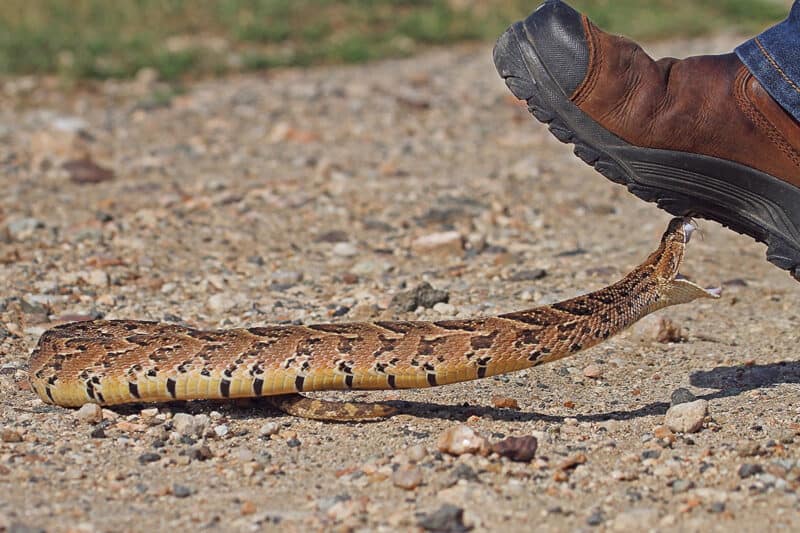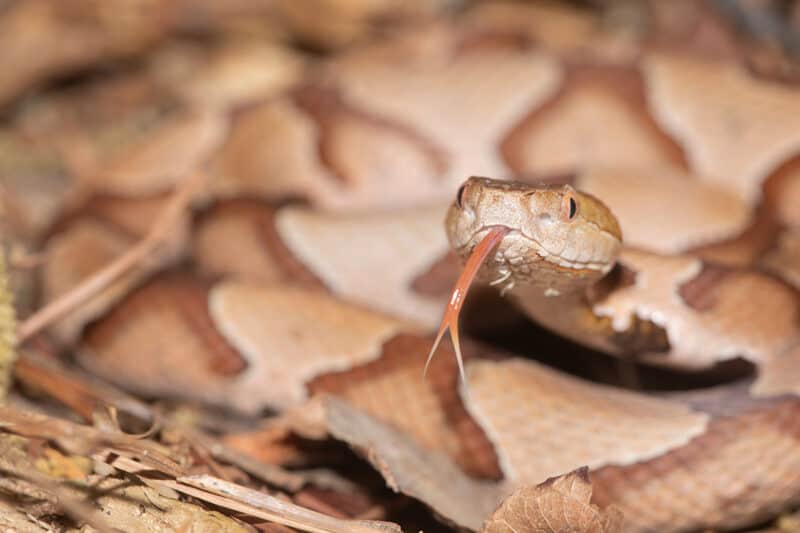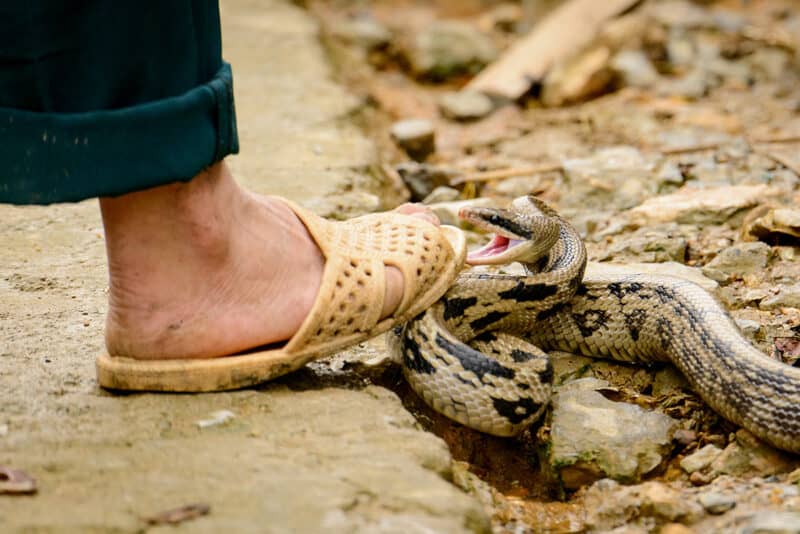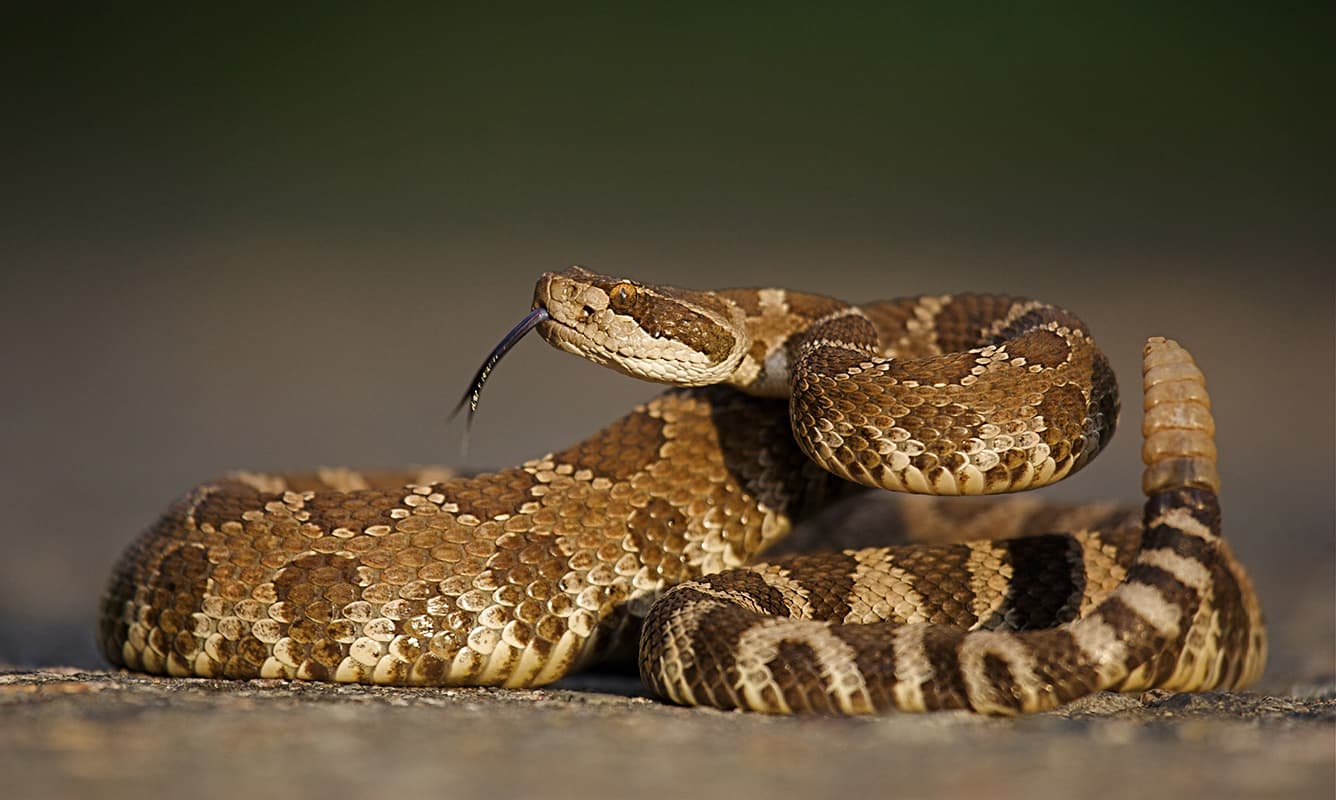If you’re living, gardening, homesteading in an area where there are venomous reptiles, you’re bound to encounter one eventually. That’s absolutely okay.
When you’re aware of all the issues you may potentially face, then you’ll be well prepared if and when it happens. Let’s take a look at some solid things you should (and shouldn’t) do if you happen upon a venomous snake in your garden.
Things You Should Do
Just like any other aspect of gardening and homesteading, there are solid do’s and don’ts.
Educate Yourself About Local Snakes
Get to know the snake species that are common in your area. No matter where you’re located, there’s bound to be a herpetological society of some sort.
They’ll probably have a website where you can find various photos of “nope ropes” so you can familiarize yourself with them.
When I was volunteering on a farm in northern California, I crossed paths with what I thought was a Northern Pacific rattlesnake (Crotalus oreganus). Turned out to be a gopher snake (Pituophis catenifer) instead.
Fortunately, there is no video evidence of my reaction to encountering such a beast. Still, a lot of that embarrassing unpleasantness could have been avoided if I’d been able to differentiate these species.
Learn which species are deadly, which are non-venomous, and their respective habitats. That way, you’ll think first before cramming your hand into a bunch of rocks or fishing around inside a pile of tires.
Wear Appropriate Footwear and Clothing

If you happen to encounter a venomous snake by accidentally trodding on it, it may lash out and bite you. Well, it won’t be able to make skin contact through a solid pair of high work boots.
Should your area be prone to these creatures, try to get yourself a pair of snake-proof outdoor boots. These often use a combination of different materials such as leather, Kevlar, and some sort of synthetic weave.
Make sure these boots come up your leg at least 16” to 18”.
As an aside, although they’re lovely and comfortable for working in the garden, standard Wellington-type rain boots won’t protect you from most venomous snake bites.
They might seem sturdy, but rattlesnake fangs can punch through that material in no time.
If you’re trying to figure out whether your boots will protect you from a snake bite or not, try this experiment: take a nail that’s about ½” thick by 2” long.
Then smack the business end of it hard against the upper portion of your boot (preferably when it’s stuffed with newspaper and not your own lower leg). If it bounces off, you should be fine.
Otherwise, if it pokes right through, then you’ll need a different pair to keep you better protected.
You’ll probably also need a new pair of Wellies, but I digress…
Things To NOT Do
Just like that handy “do” list above, there are some things you shouldn’t do to, or with, a venomous snake in your yard.
Panic
This one is easier said than done, but try not to panic if you encounter a venomous snake.
Just back away and go back into the house. If you have kids or pets with you, try to keep calm, so you don’t agitate them. Gather them up and usher them back into the house as well.
Then lock the door behind you so the snake can’t follow.
Try to Kill It or Chase It Away
Many (most) snakes don’t want anything to do with people. In fact, they’ll likely turn tail and flee if they come across any. That’s not the case for all of them, though.

Many rattlesnakes, including Copperheads (Agkistrodon contortrix), and other venomous snakes like Saw-Scaled Vipers (Echis carinatus) and Black Mambas (Dendroaspis polylepis) are seriously aggressive.
If you try to chase off or kill any of these, they’ll probably try to kill you right back.
Do you really want to risk that? No, you do not.
Instead, call your local police department and/or animal control center. They’ll be able to deal with it safely and humanely, and you’ll save yourself a trip to the emergency room.
After all, these snakes have as much right to be here as we do. We just don’t want them in our homes or gardens.
What to Do if You Get Bitten

This is hopefully a worst-case scenario, but it could happen. If it does, at least you’ll know the protocol on how to deal with it.
Step 1: Call an ambulance. Depending on the snake bite, you might get delirious or experience paralysis within a few minutes of being bitten. So call immediately.
Step 2: Try not to move, unless the venomous snake is still close by. If it’s slithered off, sit or lie down and don’t move around too much. Take slow, even breaths. This will slow the rate of the venom moving through your body.
Step 3. Apply pressure, if you can. Take a piece of clothing and press it to the bite wound, but don’t tie a tourniquet or try to cut and suck the venom out. Just keep applying gentle pressure, breathing slowly, and remaining still.
If you’re conscious when the ambulance arrives, try to describe the snake that bit you. That makes it easier for them to figure out which antivenin to administer.
Additional Tips:
There are, of course, a few extra things you can do both to avoid this situation, to begin with, and potentially deal with it if and when it occurs.
Take Defensive/Precautionary Measures
Should you live in a place where venomous snakes are common, even abundant, then taking preventative measures might be a good idea.
For instance, you can have a snake-proof fence installed or create one on your own. I didn’t know these existed until I worked in hot, dry climates, but it’s great that this is an option.
There are two main types of rattlesnake-proof fences: smooth vinyl and very, very fine mesh.
The smooth vinyl fences are commonly used as privacy screens. Unlike wooden fences, the vinyl surface doesn’t allow the snake to gain any purchase. Therefore, it can’t climb over the fence and into your garden.
Just take a moment to process the idea that snakes can climb. Yeahhhhh.
Okay, the next option is super-fine mesh. Since snakes can squeeze through surprisingly tiny holes, you’ll want to choose mesh that’s no bigger than 1/4 inch.
Whatever material you’re choosing, make sure to dig deep into the ground when you install. If at all possible, sink the fencing material into the concrete.
This will prevent other, diggy animals like foxes from burrowing beneath it, allowing the venomous snake access into your property. Don’t leave any (ANY) gaps between the fencing and the supportive posts.
Additionally, you might want to create your fences so they tilt outwards at a slight angle. This way, if the nope ropes do find a way to climb (eeeek), they’ll fall off before they can reach the top.
Make Your Property Inhospitable
Snakes like comfort. A lot. so don’t let hunker down and get comfy. They like to seek warm, cozy places in the fall and winter and sometimes move into basements, barns, chicken coops, and even outhouses.
Seal these spaces off and don’t store anything at ground level that they might be able to crawl into.
That goes for year-round storage too. If you keep your garden hose coiled up in the garden, try to store it in a container you can latch closed. This will keep slithery neighbors from curling up within the coils.
Keep grass cut short so they won’t want to hide in it, as they don’t like being exposed. If possible, keep woodpiles stacked tightly, either in a shed or well off the ground. Oh, and clamp fine wire mesh over the bottoms of drainpipes, so they don’t crawl up into them.
Snakes also don’t like rough gravel or similar coarse textures against their skin. If you’re mostly growing in raised beds or other containers, consider surrounding them with gravel.
As an aside, snakes like to congregate in places where their prey is plentiful. Keep your compost area clean and well-maintained, so it doesn’t attract rodents, and snakes will be less likely to call that area home.
Keep Emergency Numbers Handy
In addition to the standard emergency number (911 in the USA and Canada, 999 in the UK), be sure to program local poison control center numbers into your phone. The same goes for local hospitals.
Don’t just put these into your phone either: write them on an “important numbers” list and tape it to the fridge.
On the off chance that a venomous snake bites you and you’re too feverish and disorientated to give your friends your phone code, they’ll have the number(s) handy right there.
We share this planet with venomous and dangerous animals, and it’s good to recognize their role in the wider ecosystem. If they weren’t meant to be here and didn’t play an important part, they wouldn’t be around.
Life can never be made “safe,” but by taking some precautionary measures and having calm, common sense, we can all enjoy the great outdoors with much more peace.
Snakes too.












